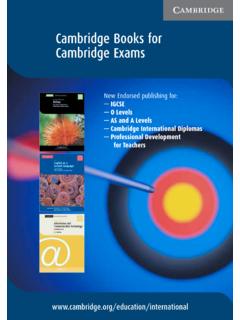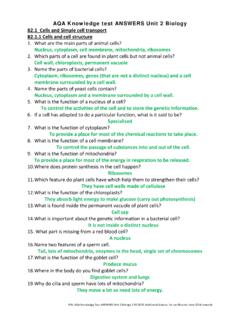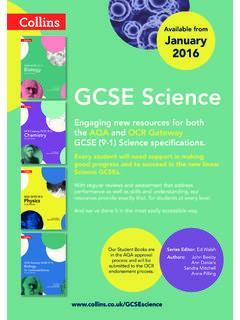Transcription of GCSE Biology Textbook sample - filestore.aqa.org.uk
1 2 AQA GCSEB iologyThird editionAnn FullickAndrea CoatesEditor: Lawrie Ryan Biology Third editionAQAK erboodle provides digital Lessons, Resources and Assessment for use in the classroom and at home, plus Kerboodle Online Student Book access for teachers and students is included in the 's on the cover?Foliose coral colony growing on a reef. Colonies are often more than 5 metres in length. Approved by AQA These new editions have been written specifically for the new 2016 AQA gcse (9-1) specifications and approved by AQA Making assessment and progress tracking easy AQA gcse Sciences Third Edition has built-in assessment and progress tracking based on the widely adopted structure used in Activate for KS3, to support effective assessment throughout the new linear courses.
2 It also includes a unique checkpoint system for intervention Supporting students of all abilities Supporting students of all abilities through the new, more demanding gcse , with ramped questions and differentiated outcomes covering the topics in the course, and additional differentiated support on Kerboodle Building maths skills The only AQA science resources with exclusive, direct, specification-matched links to MyMaths, via Kerboodle, as well as worked examples, practice questions throughout the Student Books, calculation sheets, and interactive maths activities Prepare for the new practicals Developing practical skills throughout the Student Books, with specific practice for the new practical questions and a bank of practical activities on Kerboodle Plenty of practice questions Multiple-choice, maths, practical, and synoptic practice questions are included throughout Accompanied by AQA gcse Sciences Third Edition is accompanied by Kerboodle - lessons, resources.
3 And assessment to support science teaching and learningGCSEAQA gcse Biology Third edition1 How to get in touch:web 01536 452620 fax 01865 3134722978 0 19 835939 5978 0 19 835938 8978 0 19 835927 2978 0 19 835926 5978 0 19 835928 92 Lawrie RyanRay PeacockSeries Editor: Lawrie RyanGCSEAQA Chemistry Third editionGCSE Physics Third edition2 Jim BreithauptGary CalderSeries Editor: Lawrie RyanAQAGCSE Biology for gcse Combined Science: Trilogy Third edition2 Ann FullickEditor: Lawrie RyanAQA2 Lawrie RyanEditor: Lawrie RyanGCSEAQA Chemistry for gcse Combined Science: Trilogy Third editionGCSE Physics for gcse Combined Science: Trilogy Third edition2 Jim BreithauptEditor: Lawrie RyanAQA978 0 19 830885 0 Communicable diseases are caused by pathogens microorganisms that can be spread from one organism to another.
4 In this section you will learn how we defend ourselves from the pathogens that attack us, and how our lifestyles affect our risk of developing non-communicable diseases such as heart disease and will also learn about photosynthesis in plants the process where they use light to make sugar from carbon dioxide and water. You will also look at respiration all living organisms use respiration to transfer the energy they need to carry out the reactions required for and bioenergeticsKey questions What are communicable diseases and how can we prevent them? How can your lifestyle affect your risk of developing many non-communicable diseases?
5 How do plants use the glucose they make during photosynthesis? What is the difference between aerobic and anaerobic respiration?Making connections You will learn about genetic diseases, which are not infectious but can be passed from parents to their offspring, in B13 Reproduction You will discover the importance of photosynthesis in feeding relationships and ecological communities in B16 Adaptations, interdependence, and competition and B17 Organising an ecosystem. You will find out how pollution of a waterway by fertilisers or sewage can make it impossible for water animals to respire in B18 Biodiversity and PracticalsPracticalTopic2 Investigating the effects of antiseptics and intensity and the rate of already will consequences of imbalances in the about the impact of obesity on human importance of bacteria in the human digestive role of bacteria and other pathogens in human and plant diseases.
6 And how to calculate the effect of antibacterial chemicals by measuring the area of zones of impact of exercise and smoking on the human gas exchange exercise and smoking can affect the health of other systems of the basic principles of to measure and calculate the rate of photosynthesis, and how different factors affect the rate of effects of recreational drugs on behaviour, health, and life to interpret data to understand the effect of lifestyle factors including diet, alcohol, and smoking on the incidence of non-communicable diseases at local, national, and global differences between aerobic and anaerobic an oxygen debt builds up during anaerobic respiration in your muscles.
7 B5 Communicable diseases7475 Learning objectivesAfter this topic, you should know: what health is the different causes of ill health how different types of disease health problems interactIn the next three chapters you will be looking at different types of diseases in isolation. It is important to remember that in the real world, different diseases and health conditions happen at the same time. They interact and often one problem makes another worse. Here are a number of examples you will learn more about the details of many of these conditions in later chapters.
8 Viruses living in cells can trigger changes that lead to cancers for example, the human papilloma virus can cause cervical cancer. The immune system of your body helps you destroy pathogens and get better. If there are defects in your immune system, it may not work effectively. This may be a result of your genetic makeup, poor nutrition, or infections such as HIV/AIDS. This means you will be more likely to suffer from other communicable diseases (Figure 2). Immune reactions initially caused by a pathogen, even something like the common cold, can trigger allergies to factors in the environment.
9 These allergies may cause skin rashes, hives, or asthma. Physical and mental health are often closely linked. Severe physical ill health can lead to depression and other mental illness. Malnutrition is often linked to health problems including deficiency diseases, a weakened immune system, obesity, cardiovascular diseases, type 2 diabetes, and interaction between different factors, including lifestyle, environment, and pathogens, is an important principle to remember as you look at different types of health is a state of physical and mental well-being, not just an absence of disease.
10 It is at least partly based on individual perceptions. A cold or headache that might make you feel ill enough to stay in bed on a school day might be less likely to be a problem if you are on makes us ill?Communicable (infectious) diseases ( , tuberculosis and flu) are caused by pathogens such as bacteria and viruses that can be passed from one person to another. Non-communicable diseases cannot be transmitted from one person to another ( , heart disease and arthritis). Both communicable and non-communicable diseases are major causes of ill health, but other factors can also affect health.



















